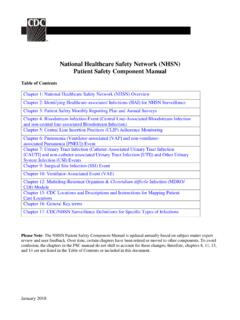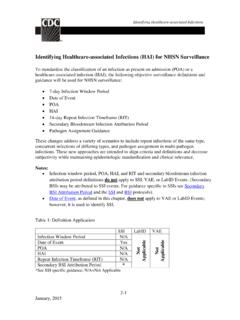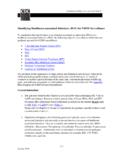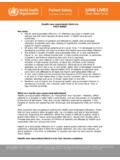Transcription of Surgical Site Infections: Classification, Risk factors ...
1 Rajviret 2 (3), 2014, Page-203-214203 International Journal of Pharma Research and Health Sciences. All rights reservede-ISSN: 2348-6465 ReviewArticleSurgical site infections : classification , Risk factors , Pathogenesis andPreventive ManagementRajvir Singh1, *,Pooja Singla1, Uma Chaudhary21 Demonstrator, Department of Microbiology, Pt. B. D. Sharma PGIMS Rohtak, Professor and HOD,Department ofMicrobiology, Pt. B. D. Sharma PGIMS Rohtak, R T I C L E I N F OA B S T R A C author *Dr. Rajvir SabharwalDemonstrator, Department of Microbiology, Pt. B. D. Sharma PGIMSR ohtak, site infections (SSIs) are the most commonpost-operative complications even in hospitals withmost modern facilities and standard protocols ofpreoperative preparation and antibiotic 3-5% of patients who undergo elective surgery,develop SSIs.
2 These are the third commonestnosocomial infections and account for approximately10-40% of all health care associated (HAI) 2002, US centre of disease control have estimatedInternational Journal of Pharma Research and Health SciencesAvailable online :04 May2014 Accepted: 20 Jun2014 Surgical site infections are one of the most common nosocomial infections besidespneumonia, urinary tract infections , and blood-stream infectionsWound classification isan importantpredictor of the risk of postoperative SSIs. Surgical site infections (SSIs) aredefined as infections occurring up to 30 days after surgery (or up to one year after surgeryin patients receiving implants) and affecting either the incision or deep tissue attheoperation site .
3 These infections have a tremendous impact on morbidity and mortality asSSIs doubled the patient s risk of death after aureus, coagulase-negative staphylococci,Enterococcusspp. andEscherichia coliare the most commoncausative pathogens. Much of the morbidity and mortality caused by SSI is words: Surgical , Infection, Urinary tract, Morbidity, 2 (3), 2014, Page-203-214204 International Journal of Pharma Research and Health Sciences. All rights reservedthat about 27 million operations are performed eachyear in United States which result in approximately300000 SSIs every year and cause approximately 8000patient deaths. These infections have a tremendousimpact on morbidity and mortality as SSIs doubled thepatient s risk of death after surgery.
4 Extra bedoccupancy is an important factor responsible forincreasing financial cost associated with theseinfections because of additional postoperative hospitalstay of about 7-10 days which result in extraexpenditure of about 3000-29000 US dollars per SSIdepending on Surgical procedure and , and classification of SSIIn 1992, CDC revised its definition of woundinfection , by creating the definition, Surgical siteinfection , to prevent the confusion between theinfection of a Surgical incision and the infectionof atraumatic site infections (SSIs) are defined as infectionsof skin or underlying soft tissues at the Surgical site ,occurring within 30 days following NationalHealthcare Safety Network (NHSN) operativeprocedure in which an incision was closed NHSN operative procedure is a procedure that isperformed on a patient who is an NHSN inpatient (Apatient whose date of admission to the healthcarefacility and the date of discharge are different calendardays) or an NHSN outpatient (A patient whose date ofadmission to the healthcare facility and date ofdischarge are the same calendar day).
5 And takes placeduring an operation (defined as a single trip to theoperating room (OR) where a surgeon makes at leastone incision through the skin or mucous membrane,including laparoscopic approach, and closes theincision primarily before the patient leaves the OR. Acomplete list of qualifying procedures can be found Primary closure is defined as closure of alltissue levels during the original surgery, regardless ofthe presence of wires, wicks, drains, or other devices orobjects extrudingthrough the incision. However,regardless of whether anything is extruding from theincision, if the skin edges are not fully reapproximatedfor the entire length of the incision ( , are looselyclosed with gaps between suture/staple points), theincision is not considered primarily closed andtherefore the procedure would not be considered anoperation.)
6 In such cases, any subsequent infectionwould not be considered an SSI, although it may be anHAI if it meets criteria for another specific infectionsite ( , skin or soft tissue infection). CDC classifiesSSIs in three categories: superficial incisional, deepincisional and organ/space 1: Schematic representation of the anatomical classification ofsurgical site incisional SSII nfection occurs within 30 days after any NHSN operative procedure, and involves only skin andsubcutaneous tissue of the incision and patient has atleast one of the following:1) purulent draining from the superficial ) organisms isolated from an aseptically obtainedcultureof fluid or tissue from the superficial incision(incisional drainage).
7 3) atleast one of the following signs or symptoms ofinfection: pain or tenderness, localized swelling,redness or heat, and superficial incision is deliberatelyRajviret 2 (3), 2014, Page-203-214205 International Journal of Pharma Research and Health Sciences. All rights reservedopened by surgeon, and is culture positive or ) Diagnosis of superficial incisional SSI by thesurgeon or attending following conditions as SSI1. Stitch abscess (minimal inflammation and dischargeconfined to the points of suturepenetration).2. Infection of an episiotomy or newborn Infected burn wound and localized stab woundinfection (considered as skin or soft tissue infectiondepending on its depth).
8 4. Incisional SSI that extends into the fascial andmuscle layers (see deep incisional SSI).Note:Specific criteria are used for identifying infectedepisiotomy and circumcision sites and burn and circumcision are excluded fromdefinition of SSIs because these are not NNIS operative are two specific types of superficial Incisional Primary (SIP) a superficialincisional SSI that is identified in the primary incisionin a patient that has had an operation with one or moreincisions ( , C-section incision or chest incision forCBGB). Incisional Secondary (SIS) a superficialincisional SSI that is identified in the secondaryincision in a patient that has had an operation withmore than one incision ( , donor site incision forCBGB).
9 Incisional SSII nfection occurs within 30 or 90 days after the NHSN operative procedure and involves deep soft tissues(fascial and muscle layers) of the incision and patienthas atleast one of the following:1) Purulent drainage fromthe deep incision but notfrom the organ/space component of the Surgical ) A deep incision spontaneously dehisces or isdeliberately opened by a surgeon and is culture positiveor not cultured and when the patient has at least one ofthe following signs or symptoms: fever (>38 C),localized pain, or tenderness, unless site is ) An abscess or other evidence of infection involvingthe deep incision is found on direct examination,during reoperation, or by histopathologic or ) Diagnosis of a deep incisional SSI by a surgeon orattending :1.
10 Report infection that involves both superficial anddeep incision sites as deep incisional Classify infection that involves superficialincisional,deep incisional, and organ/space sites asdeep incisional SSI. This is considered a complicationof the are two specific types of deep incisional SSIs:1. Deep Incisional Primary (DIP) a deep incisionalSSI that is identified in a primaryincision in a patientthat has had an operation with one or more incisions( , C-section incision or chest incision for CBGB).2. Deep Incisional Secondary (DIS) a deep incisionalSSI that is identified in the secondary incision in apatient that hashad an operation with more than oneincision ( , donor site incision for CBGB).






